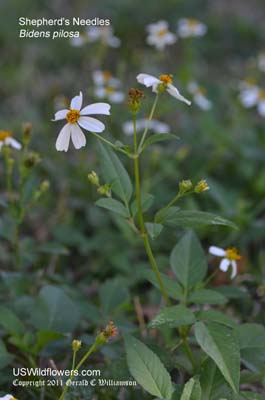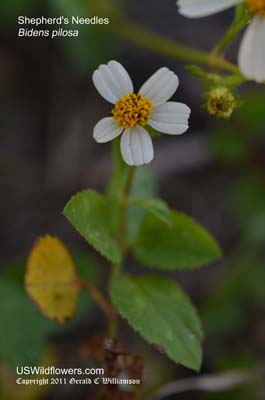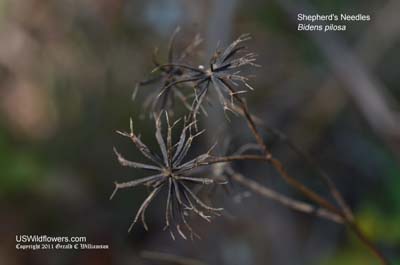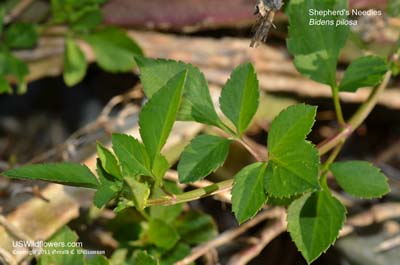Wildflowers of the United States | |||||||||||||
| |||||||||||||
Bidens pilosa - Shepherd's Needles ,Spanish Needles, Romerillo, Common Beggar's-tick, Hairy Beggarticks, Cobbler's Pegs. Synonym: Bidens alba | Many authorities (and, frankly, most folks who are not authorities) continue to consider Bidens alba a separate species from Bidens pilosa, and the plants on this page would be B. alba under those circumstances. As of January, 2012 the USDA plants database continued to maintain the separation of species, but the Integrated Taxonomic Information System (along with the Flora of North Amertica) has adopted a more recent classification which rolls B. alba and B. odorata into B. pilosa. (I know that will be a disappointment to some.) The USDA map shown does not include Missouri (as of January 2012), since if the species are considered separate B. pilosa is not found in the state, but B. alba is found there. That map also shows the plant as non-native. Bidens alba is considered native to parts of the United States. If that plant is considered a separate species, then Bidens pilosa is a non-native species. If Bidens alba is rolled into Bidens pilosa, then Bidens pilosa will need to be considered a native species in those areas where Bidens alba was considered to be native. That logic may be difficult to follow, but that's why I indicate B. pilosa to be a native species while the USDA map shows it to be introduced. On a December, 2011 trip to Florida Shepherd's Needles seemed to become the dominant flowering plant along the highways by the time we got as far south as Gainesville. It seemed to be everywhere, and is officially considered a weedy or invasive plant in Hawaii, where it is not native. It's also considered weedy and invasive in much of the rest of the tropical world, where it has spread as man's travel has spread. While the plant may (probably will!) spread where it is not wanted, it is reported to be a great attractor for butterflies. Found in: AL, AZ, CA, CT, FL, GA, HI, KY, LA, MA, MD, MO, MS, NC, NM, OR, PA, SC, TX, WI Leave comments on Bidens pilosa at this link.   Blue=Native; Grey=Introduced Map from USDA Plants Database: USDA, NRCS. 2017. The PLANTS Database (http://plants.usda.gov, 26 Apr 2025). National Plant Data Team, Greensboro, NC 27401-4901 USA. Search Our Database: Enter any portion of the Scientific, Common Name, or both. Do a general Google search of the entire site: #ad #ad
| #ad
| | ||||||||||
|
Commercial / Cookie Notice Looking for Wildflowers for a specific state? Check here: | |||||||||||||
|
| |||||||||||||





